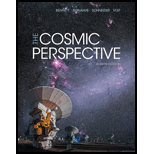
A Cold Solar Nebula. Roles: Scribe (take notes on the group’s activities), Proposer (proposes explanations to the group), Skeptic (points out weaknesses in proposed explanations), Moderator (leads group discussion and makes sure everyone contributes). Activity: In our solar system, the frost line was located between Mars and Jupiter, but study of other solar systems suggests that our solar system could have turned out differently. Consider a hypothetical scenario in which the solar nebula was not cleared away by the solar wind until the entire disk of gas had cooled to 50 K.
a. Make a list of ingredients that will condense at 50 K.
b. Make a list of ways in which the terrestrial planets might have turned out differently under this alternative formation scenario. c. Repeat part b for the jovian planets. D. Discuss the likelihood that your predicted changes would match the actual characteristics of this alternative solar system. E. Come up with additional “what if” scenarios, discussing various ways in which planets might have turned out differently.
Trending nowThis is a popular solution!

Chapter 8 Solutions
COSMIC PERSPCTV&MOD MST ET AC&SKYGAZER 5.0 PK
- Which step(s) listed in the previous question can be eliminated in models that form Jovian planets in thousands of years, a time frame that solves the Jovian problem? Order the following steps in the formation of a Terrestrial planet chronologically: gravitational collapse, accretion, outgassing, condensation, and differentiation.arrow_forwardDescribe the solar nebula, and outline the sequence of events within the nebula that gave rise to the planetesimals.arrow_forwardWhat can we learn about the formation of our solar system by studying other stars? Explain.arrow_forward
- How does the solar nebula theory explain the orbits of the major planets? Dwarf planets? Does it explain the rotations of the planets? Why or why not?arrow_forwardHow does the solar nebula theory explain the significant density difference between the Terrestrial and Jovian planets?arrow_forwardWhat is a biomarker? Give some possible examples of biomarkers we might look for beyond the solar system.arrow_forward
- Suppose that Earth grew to its present size in 1 million years through the accretion of particles averaging 100 grams each. On the average, how many particles did Earth capture per second? (Note: Earth’s mass is 6.01027 grams.)arrow_forwardWhat is comparative planetology and why is it useful to astronomers?arrow_forwardOrder the following steps in the formation of a Terrestrial planet chronologically: gravitational collapse, accretion, out-gassing, condensation, and differentiation.arrow_forward
- What was the solar nebula like? Why did the Sun form at its center?arrow_forwardIf you could visit another planetary system while the planets are forming, would you expect to see the condensation sequence at work, or do you think that process was most likely unique to our Solar System? How do the properties of the extrasolar planets discovered so far affect your answer? Do you expect the most planetary system in the Universe have analogs to our Solar System’s asteroid belt and Kuiper Belt? Would all planetary systems show signs of an age of heavy bombardment? If the solar nebula hypothesis is correct, do you think there are more planets in the Universe than stars? Why or why not?arrow_forwardImagine a trans-Neptunian object with roughly the same mass as Earth but located 50 AU from the sun. a) based on the solar nebula theory, what do you think this object would be made of and why? b) on the basis of speculation, assume a reasonable density for this object and calculate its diameter in units of Earth radii.arrow_forward

 Foundations of Astronomy (MindTap Course List)PhysicsISBN:9781337399920Author:Michael A. Seeds, Dana BackmanPublisher:Cengage Learning
Foundations of Astronomy (MindTap Course List)PhysicsISBN:9781337399920Author:Michael A. Seeds, Dana BackmanPublisher:Cengage Learning AstronomyPhysicsISBN:9781938168284Author:Andrew Fraknoi; David Morrison; Sidney C. WolffPublisher:OpenStax
AstronomyPhysicsISBN:9781938168284Author:Andrew Fraknoi; David Morrison; Sidney C. WolffPublisher:OpenStax Horizons: Exploring the Universe (MindTap Course ...PhysicsISBN:9781305960961Author:Michael A. Seeds, Dana BackmanPublisher:Cengage Learning
Horizons: Exploring the Universe (MindTap Course ...PhysicsISBN:9781305960961Author:Michael A. Seeds, Dana BackmanPublisher:Cengage Learning
 An Introduction to Physical SciencePhysicsISBN:9781305079137Author:James Shipman, Jerry D. Wilson, Charles A. Higgins, Omar TorresPublisher:Cengage Learning
An Introduction to Physical SciencePhysicsISBN:9781305079137Author:James Shipman, Jerry D. Wilson, Charles A. Higgins, Omar TorresPublisher:Cengage Learning





